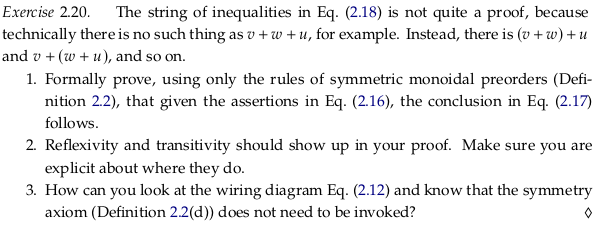Exercise 2.20#

Using reflexivity, we have that \(u \leq u\). Add this to the first of the equations in (2.16), using
(a) (monotonicity) in the definition of a symmetrical monoidal preorder:
\[\begin{split}
\begin{align} \\
t & \leq v + w \\
u & \leq u \\
t + u & \leq (v + w) + u \\
\end{align}
\end{split}\]
Similarly for the second equation:
\[\begin{split}
\begin{align} \\
w + u & \leq x + z \\
v & \leq v \\
v + (w + u) & \leq v + (x + z) \\
\end{align}
\end{split}\]
And the third equation:
\[\begin{split}
\begin{align} \\
v + x & \leq y \\
z & \leq z \\
(v + x) + z & \leq y + z \\
\end{align}
\end{split}\]
Using associativity and transitivity, we can combine all three of these equations to get Equation (2.18) in the text.
To answer 3., the symmetry axiom does not need to be invoked because wires do not cross.